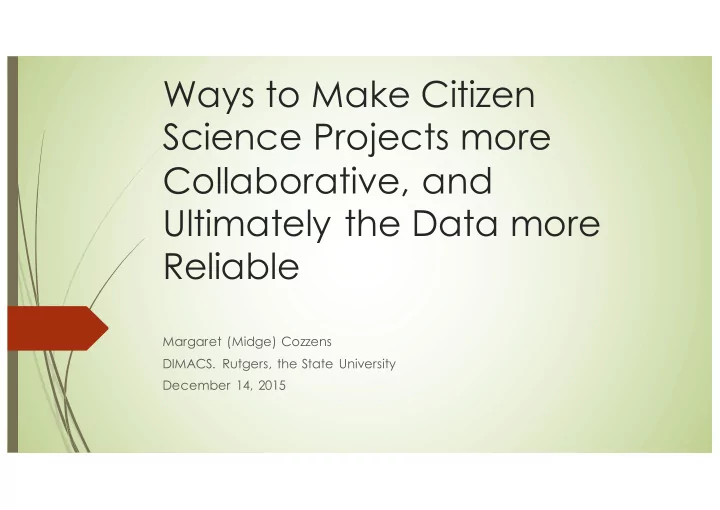

Ways to Make Citizen Science Projects more Collaborative, and Ultimately the Data more Reliable Margaret (Midge) Cozzens DIMACS. Rutgers, the State University December 14, 2015
Citizen Science Citizen science has the power to engage citizens of all ages in all countries in the world in science and mathematics while collecting valuable data. They very often contribute valuable observations and insights. Today's technology has made all of this possible as citizens and scientists collaborate across the globe using cell phones and computers. photo credit – NOAA Mesa Project on phytoplankton
Citizen science = crowd sourcing Human computing power harnessed from ordinary citizens across the world has the potential to accelerate the pace of health care research of all kinds, says a team from the Perelman School of Medicine at the University of Pennsylvania in a new review published online in the Journal of General Internal Medicine . In fact, they suggest, crowdsourcing (citizen science) – a research method that allows investigators to engage thousands of people to provide either data or data analysis, usually via online communications – could even improve the quality of research while reducing the costs. “While the concept of ‘citizen science’ has been in existence for more than a century and crowdsourcing has been used in science for at least a decade, it has been utilized primarily by non-medical fields and little is known about its potential in health research,” said the study’s senior author Raina Merchant, MD , an assistant professor of Emergency Medicine at Penn and director of the new Social Media Lab at Penn.
Mathematical and Computational Learning through Citizen Science Examples of ways citizen participants can learn various mathematical and computational tools as they collect important data and make crucial observations. Pattern matching or recognition using CT scans to identify anamalies in tumors or in satellite images for locating the downed Malaysian airline. Feature analysis is the usual pattern recognition technique used and includes the following stages: detection, pattern dissection, feature comparison in memory, and recognition from memory.
Health Examples There are 21 health-related studies in the literature that include citizen science or crowdsourcing techniques. The studies collectively engaged a crowd of over 136,000 people, ranging in focus from tracking H1N1 influenza outbreaks in near real time to classifying different types of polyps in the colon.
Reliability “There is understandably some apprehension about letting the lay public in on medical research or even assisting with making medical diagnoses because the stakes are so high in medicine. However, studies we reviewed showed that the crowd can be very successful, such as solving novel complex protein structure problems or identifying malaria infected red blood cells with a similar accuracy as a medical professional,” said the Penn study’s first author Benjamin Ranard, a third year medical student in the Perelman School of Medicine.
Other Examples ´ Researchers from the Perelman School of Medicine at the University of Pennsylvania used crowdsourcing in a study to pinpoint and record the locations of about 1,400 lifesaving automated external defibrillators (AEDs) in public places in Philadelphia. ´ GoViral Study is a crowdsourcing research project that collects fluid specimens from the community and analyzes them with the latest molecular diagnostics instruments. The study examines viral and symptom information from people in one community and examine how this can be used to predict an individual's risk of influenza and other respiratory and gastrointestinal illnesses. A self-collected specimen kit is sent to participants and at any time someone gets sick, they are asked to provide a nasal swab, saliva or fecal sample. The study is being conducted by Dr. Rumi Chunara at New York University, and it is being funded by the National Science Foundation and is part of Open Humans.
Even Games become tools in citizen science Play to cure : Genes in space is a Cancer Research UK mobile game which is free to download on iOS and Android. The game allows players to help analyse DNA data by controlling the path of a spaceship. EteRNA is a collaborative online game in which volunteers help biologists solve a challenging mystery: what are the rules governing RNA folding? Players who assemble the best RNA designs online will see their creations synthesized in a biochemistry lab.
EyeWire EyeWire EyeWire is a citizen science project aimed at mapping the neural connections of the retina. All you have to do is play a relaxing and absorbing game of coloring brain images! In the game, participants reconstruct the tree-like shapes of the neurons in the retina. By tracing branches throughout images, you can help the computer develop 3-D reconstructions of the neurons.
Statistical Analysis Elementary statistical analysis of collected data with known data used in areas of conservation biology and environmental science. Participants learn to graphically display their data, compute means and comparisons of means. In newer examples participants create hypothesis about why anomalies occur and compare them to the experts.
Shared Values Partners define values (along with mission and vision) collaboratively to ensure buy-in. Shared values not only govern how the partners collaborate to implement the strategic plan, but also anchor partners to a sense of purpose.
Skills The programs require cultivation and transfer of skills between participants, who lack expertise in scientific data collection, and scientists with the technical knowledge. Those involved are inspired to: ´ Learn scientific, mathematical and computational procedures and background, ´ Learn from mistakes, and ´ Generate new hypotheses and ideas for procedural improvement.
Recommend
More recommend